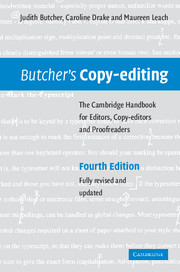Book contents
- Frontmatter
- Contents
- List of illustrations
- Preface to the fourth edition
- Preface to the third edition
- Preface to the second edition
- Preface to the first edition
- Acknowledgements
- 1 Introduction
- 2 Preliminary copy-editing, design and specimen pages
- 3 Preparing the text for the typesetter
- 4 Illustrations
- 5 Proofs
- 6 House style
- 7 Preliminary pages
- 8 Indexes
- 9 Other parts of a book
- 10 Bibliographical references
- 11 Literary material
- 12 Multi-author and multi-volume works
- 13 Science and mathematics books
- 14 Other special subjects
- 15 Reprints and new editions
- 16 On-screen editing
- Appendixes
- Glossary
- Select bibliography and other resources
- Index
4 - Illustrations
Published online by Cambridge University Press: 05 August 2012
- Frontmatter
- Contents
- List of illustrations
- Preface to the fourth edition
- Preface to the third edition
- Preface to the second edition
- Preface to the first edition
- Acknowledgements
- 1 Introduction
- 2 Preliminary copy-editing, design and specimen pages
- 3 Preparing the text for the typesetter
- 4 Illustrations
- 5 Proofs
- 6 House style
- 7 Preliminary pages
- 8 Indexes
- 9 Other parts of a book
- 10 Bibliographical references
- 11 Literary material
- 12 Multi-author and multi-volume works
- 13 Science and mathematics books
- 14 Other special subjects
- 15 Reprints and new editions
- 16 On-screen editing
- Appendixes
- Glossary
- Select bibliography and other resources
- Index
Summary
Printed illustrations are of two kinds: line and halftone. In academic books they are usually provided by the author and may come in the form of original line drawings and glossy prints or transparencies, or electronic files, accompanied by a hard copy of each figure.
Line illustrations
These include diagrams, maps and graphs. They are drawn with solid black lines, with no gradations of grey, though shading can be provided by a pattern of dots or lines called a tint, as in figure 4.4. Line drawings may also be needed for some things that are not pictures but cannot be reproduced by the author or by all typesetters. These may include ringed or crossed-out letters, numbers or words; chemical formulae with rings or diagonals; music; structural diagrams in linguistics books; non-roman characters; and genealogical tables. If the book contains such diagrams or symbols, check with the designer or production department whether they can be typeset or will be drawn by the typesetter or an artwork studio.
Documents such as newspaper cuttings may also be used as artwork rather than reset.
Halftones and coloured images
Halftone reproduction is needed for illustrations such as photographs and wash drawings, which contain gradations of tone between black and white. It may also be needed to reproduce old engravings. Note that not all photographs are halftones: an author may provide photographic prints of finished artwork for diagrams; but these are not halftones if there is not a continuous gradation of tone.
- Type
- Chapter
- Information
- Butcher's Copy-editingThe Cambridge Handbook for Editors, Copy-editors and Proofreaders, pp. 69 - 94Publisher: Cambridge University PressPrint publication year: 2006



